Sri Anandpur Sahib

Where History and Devotion Meet
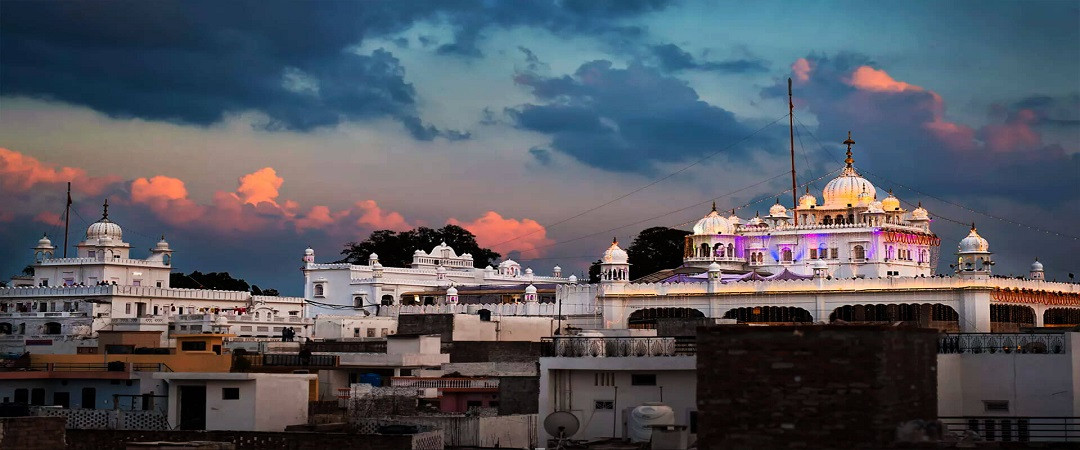
Sri Anandpur Sahib

Where History and Devotion Meet

Anandpur Sahib in Rupnagar district is the birthplace of Khalsa panth. Sri Guru Tegh Bahadur Ji, the ninth Sikh Guru, laid the foundation of Anandpur Sahib on the banks of river Sutlej, where later during the period of Sri Guru Gobind Singh Ji, the ‘Khalsa’ was born. Sri Keshgarh Sahib is one of the five sacred Takhts (religious seats) of Sikh religion is located here. An annual Hola Mahalla festival is held here during the month of March. Anandpur Sahib is the most visited pilgrimage site after Sri Harmandir Sahib in Amritsar. The town has many other religious, historic and natural sites for visit by the tourists.
Takht Sri Keshgarh Sahib
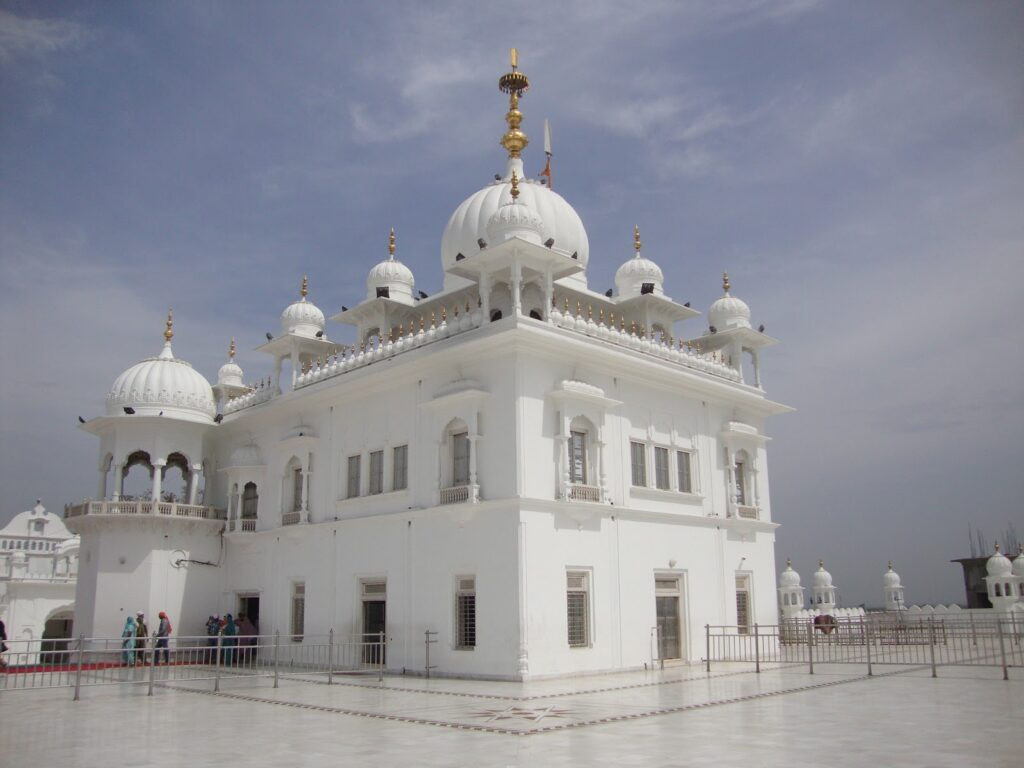 Takht Sri Keshgarh Sahib is the principal shrine in Anandpur Sahib. This is the historic site where, on the day of Baisakhi in 1699, Sri Guru Gobind Singh Ji initiated his followers into the order of the Khalsa. It was here Sri Guru Gobind Singh Ji baptised five brave men with amrit (holy water). In the sanctum sanctorum of Takht Sri Keshgarh Sahib, the belongings of Guru Gobind Singh – a khanda, a dagger, a shield, a chakkar, three swords and several spears – are preserved.
Takht Sri Keshgarh Sahib is the principal shrine in Anandpur Sahib. This is the historic site where, on the day of Baisakhi in 1699, Sri Guru Gobind Singh Ji initiated his followers into the order of the Khalsa. It was here Sri Guru Gobind Singh Ji baptised five brave men with amrit (holy water). In the sanctum sanctorum of Takht Sri Keshgarh Sahib, the belongings of Guru Gobind Singh – a khanda, a dagger, a shield, a chakkar, three swords and several spears – are preserved.
Virasat-e-Khalsa Museum

(Facilities available: cafeteria, free-of-cost wheelchairs for differently abled)
Designed by acclaimed architect Moshe Safdie, this story-telling repository is the first of its scale in the world and has been envisioned as the world’s largest cultural and historical museum dedicated to a single community. It is also recognized as the most visited museum in the history of Indian subcontinent with over 10 million visitors in a period of 8 years. Virasat-e-Khalsa is a museum located close to Gurudwara Sri Keshgarh Sahib and is spread over an area of 120 acres with 40 acres built-up area. The museum gives visitors an insight into the Sikh history including birth of ‘Khalsa’ displayed through a series of beautiful paintings, portraying lives of all Sikh Gurus, their struggles and heritage.
Timings: 10 am to 4 pm, Entry Free,
Closed on Monday and Public Holidays.
Hola Mohalla
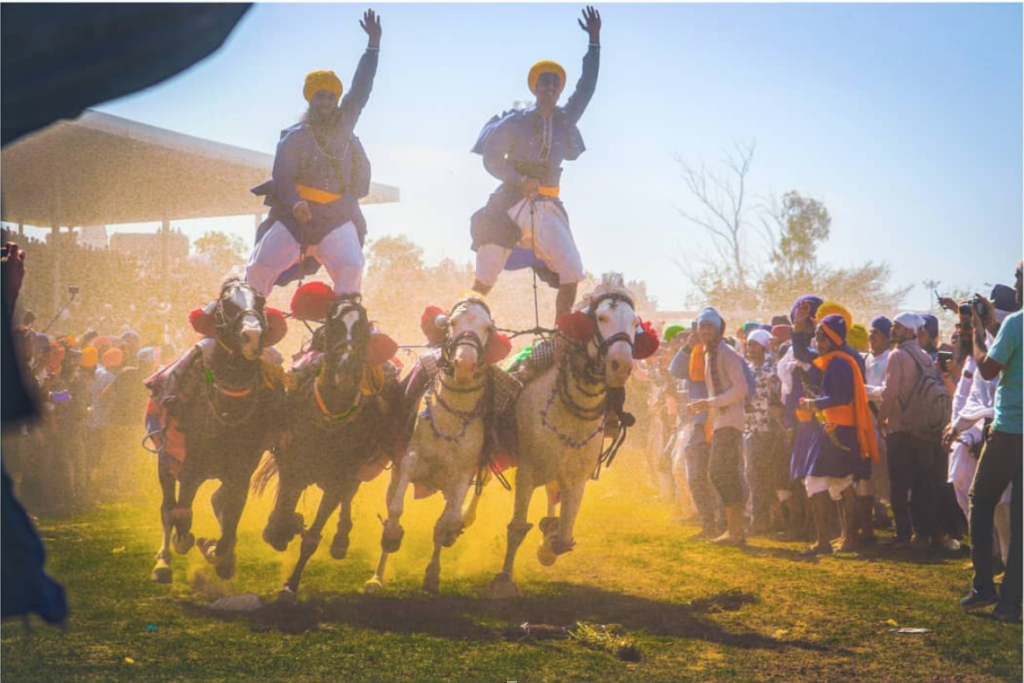 The festival of Hola Mahalla was instituted by Sri Guru Gobind Singh Ji on 22 February 1701 as a showcase for Sikh martial arts. Hola Mahalla derives its name from ‘the charge of an army’. Thus, ‘hola’, or ‘halla’, means a military charge, while ‘mahalla’ means a procession, or an army column. Some of the most breathtaking feats at Hola Mahalla are performed by skilled Nihangs. These include the dangerous arts of tent-pegging and gatka, ‘warriors’ engage in mock fights with use of real weapons and feats such as bare-back riding, and horseback acrobatics such as standing up on a horse, riding two horses at once, and more. Round the clock free langars (community serving), is served to thousands of people who throng to the place during the festival from different parts of the country. During the festival, free langars are served at many places on the roadside leading to Anandpur Sahib from different parts of the State.
The festival of Hola Mahalla was instituted by Sri Guru Gobind Singh Ji on 22 February 1701 as a showcase for Sikh martial arts. Hola Mahalla derives its name from ‘the charge of an army’. Thus, ‘hola’, or ‘halla’, means a military charge, while ‘mahalla’ means a procession, or an army column. Some of the most breathtaking feats at Hola Mahalla are performed by skilled Nihangs. These include the dangerous arts of tent-pegging and gatka, ‘warriors’ engage in mock fights with use of real weapons and feats such as bare-back riding, and horseback acrobatics such as standing up on a horse, riding two horses at once, and more. Round the clock free langars (community serving), is served to thousands of people who throng to the place during the festival from different parts of the country. During the festival, free langars are served at many places on the roadside leading to Anandpur Sahib from different parts of the State.
Other Gurudwaras
There are many other historical Gurudwaras in Sri Anandpur Sahib dedicated to the memories of Sri Guru Tegh Bahadur Ji and Sri Guru Gobind Singh Ji. Every Gurudwara has a sermon attached to it. Apart from Gurudwara Keshgarh Sahib, there are Gurudwara Sis Ganj Sahib, Gurudwara Bhora Sahib, which is an edification of Sri Guru Tegh Bahadur Ji’s residence, Gurudwara Thara Sahib, Akal Bunga Sahib, Damdama Sahib, Gurudwara Shaheedi Bagh, Gurudwara Mata Jit Kaur, Gurudwara Guru Ka Mahal and Gurudwara Manji Sahib.
Apart from the above historical and sacred Gurudwaras there are, five forts built by Sri Guru Gobind Singh These are Fort Anandgarh Sahib, Fort Fatehgarh Sahib, Fort Taragarh Sahib, Fort Lohgarh Sahib, and Fort Holgarh Sahib. The Holgarh Fort has now been converted into Gurudwara Holgarh Sahib, and all those who attend the Hola Mohalla festival eat their meals at langars provided by the organizers.
There is no dearth of accommodation in Anandpur Sahib. However, during the Hola Mohalla period, the visitor may have to stay at a distance.
Other Attractions
Jhajjar Bachauli Wildlife Sanctuary
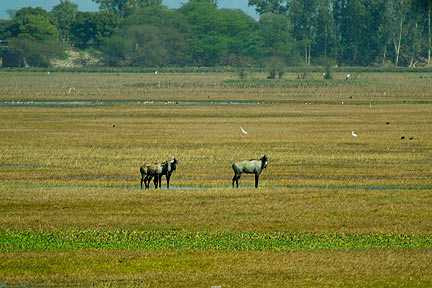 Just 5 km away from Anandpur Sahib, in the foothills of Shivalik, this wildlife sanctuary is a must visit for nature lovers and wildlife enthusiasts. The main species in this wildlife sanctuary, which can be sighted are Sambar Deer, Barking Deer, Hare, Jackal, Python, Cobra, Rat Snake, Leopard, etc. However, the visitor may be required to have prior permission from the forest office for entering into the protected area.
Just 5 km away from Anandpur Sahib, in the foothills of Shivalik, this wildlife sanctuary is a must visit for nature lovers and wildlife enthusiasts. The main species in this wildlife sanctuary, which can be sighted are Sambar Deer, Barking Deer, Hare, Jackal, Python, Cobra, Rat Snake, Leopard, etc. However, the visitor may be required to have prior permission from the forest office for entering into the protected area.
Excavation Site of Indus Valley Civilization & Archaeological Museum
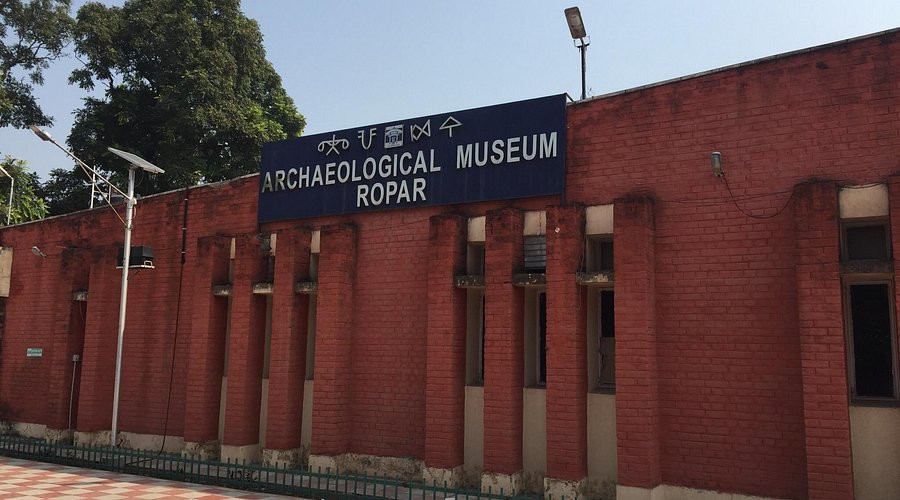 The Archaeological Museum is situated in Rupnagar town on the bank of sutlej river. The museum houses the archaeological remains of excavated site near Ropar, the first Harappan site excavated in Independent India. The excavation revealed a cultural sequence from Harappan to medieval times. Important exhibits include antiquities of Harappan times, Painted Grey ware culture, Saka. Kushana, Gupta times such as Vina Vadini (lady playing on vina), steatite seal, copper and bronze implements, ring stone, yakshi image, gold coins of Chandragupta.
The Archaeological Museum is situated in Rupnagar town on the bank of sutlej river. The museum houses the archaeological remains of excavated site near Ropar, the first Harappan site excavated in Independent India. The excavation revealed a cultural sequence from Harappan to medieval times. Important exhibits include antiquities of Harappan times, Painted Grey ware culture, Saka. Kushana, Gupta times such as Vina Vadini (lady playing on vina), steatite seal, copper and bronze implements, ring stone, yakshi image, gold coins of Chandragupta.
(Timings: 9 am to 5 pm, Closed on Friday & Public
Holidays, Entry Fee: Adult Rs.5/
Children under 15 – Freel
Sri Guru Teg Bahadur Museum
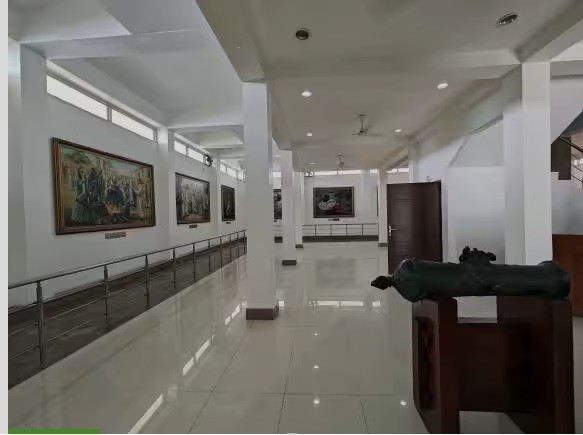 Sri Guru Tegh Bahadur Museum was built in 1983 in commemoration of the third centenary of the Guru’s martyrdom. Located near Takht Sri Keshgarh Sahib, the museum’s architecture reflects that of the gurudwara A large collection of paintings, narrating the history of the Sikhs, including depictions from Sri Guru Tegh Bahadur Ji’s life, are displayed here. The beautiful nine domes inside the museum are made of fiberglass that glitters and are a treat to watch,
Sri Guru Tegh Bahadur Museum was built in 1983 in commemoration of the third centenary of the Guru’s martyrdom. Located near Takht Sri Keshgarh Sahib, the museum’s architecture reflects that of the gurudwara A large collection of paintings, narrating the history of the Sikhs, including depictions from Sri Guru Tegh Bahadur Ji’s life, are displayed here. The beautiful nine domes inside the museum are made of fiberglass that glitters and are a treat to watch,
(Timings: 10:30 am to 6 pm, Mon-Sun)
Gurudwara Sri Parivar Vichhora Sahib
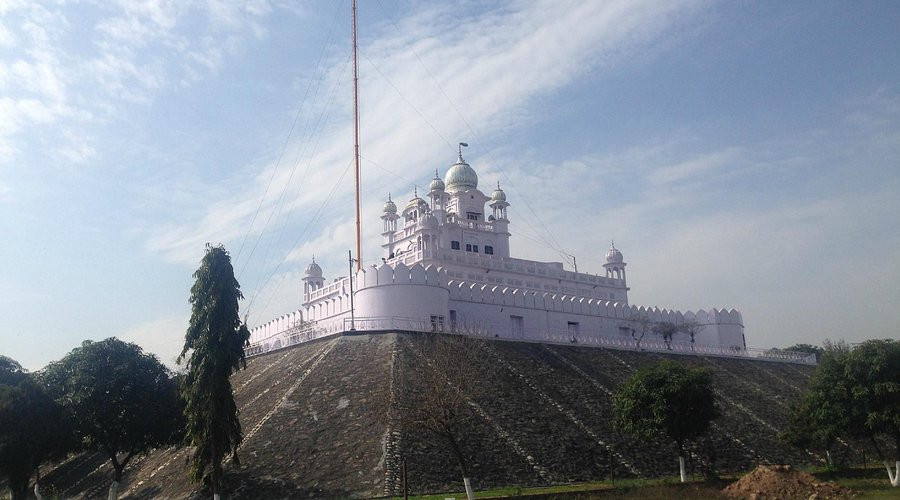 Situated near the banks of river Sirsa, Gurudwara Sri Parivar Vichhora Sahib marks the site where battle between Mughal army led by Wazir Khan and Sri Guru Gobind Singh Ji accompanied by his two sons and about 400 sikhs, was fought. At this place, some Sikhs pushed their horses into the swirling waters and carried the Guru’s family safely across 400 mt width of the river. The Gurudwara Parivar Vichhora has been raised to commemorate Sri Guru Gobind Singh Ji’s visit and his painful separation from his family.
Situated near the banks of river Sirsa, Gurudwara Sri Parivar Vichhora Sahib marks the site where battle between Mughal army led by Wazir Khan and Sri Guru Gobind Singh Ji accompanied by his two sons and about 400 sikhs, was fought. At this place, some Sikhs pushed their horses into the swirling waters and carried the Guru’s family safely across 400 mt width of the river. The Gurudwara Parivar Vichhora has been raised to commemorate Sri Guru Gobind Singh Ji’s visit and his painful separation from his family.
Sri Chamkaur Sahib
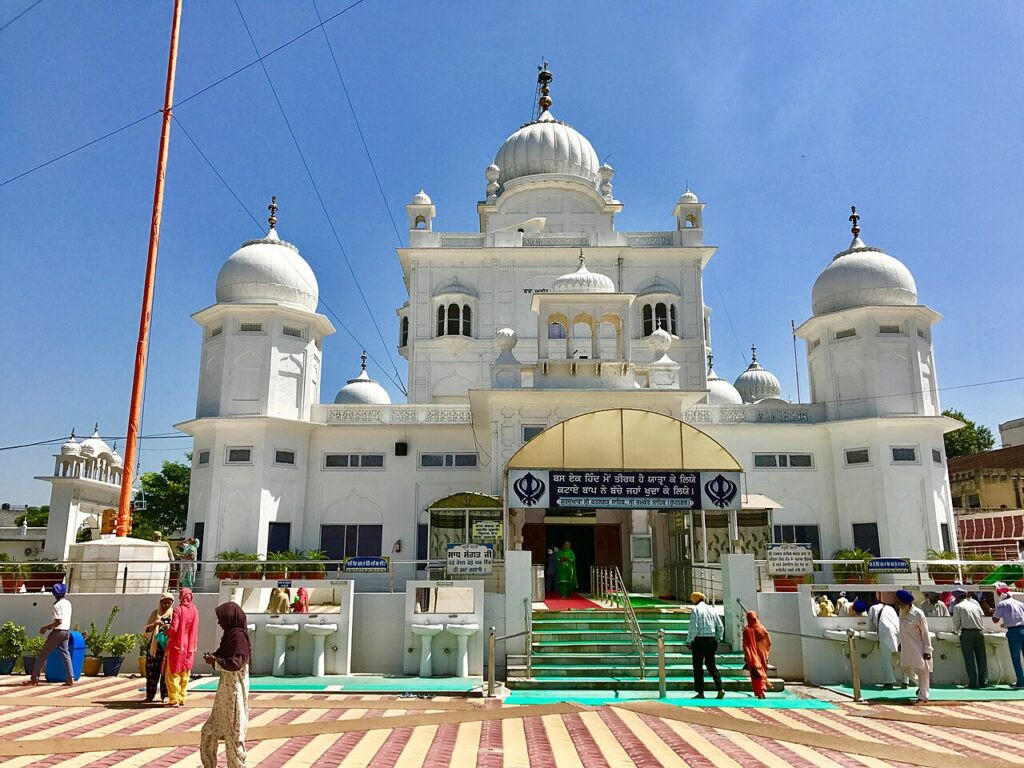 Chamkaur Sahib is the place of martyrdom of the two brave sons of the tenth Guru, Sri Guru Gobind Singh Ji, Baba Ajit Singh Ji and Baba Jujhar Singh Ji. It is here the battle of Chamkaur was fought. Devotees from around the world reach Chamkaur Sahib to visit and pay obeisance at Gurudwara Katalgarh Sahib and Gurudwara Damdama Sahib.
Chamkaur Sahib is the place of martyrdom of the two brave sons of the tenth Guru, Sri Guru Gobind Singh Ji, Baba Ajit Singh Ji and Baba Jujhar Singh Ji. It is here the battle of Chamkaur was fought. Devotees from around the world reach Chamkaur Sahib to visit and pay obeisance at Gurudwara Katalgarh Sahib and Gurudwara Damdama Sahib.
Gurudwara Katalgarh Sahib
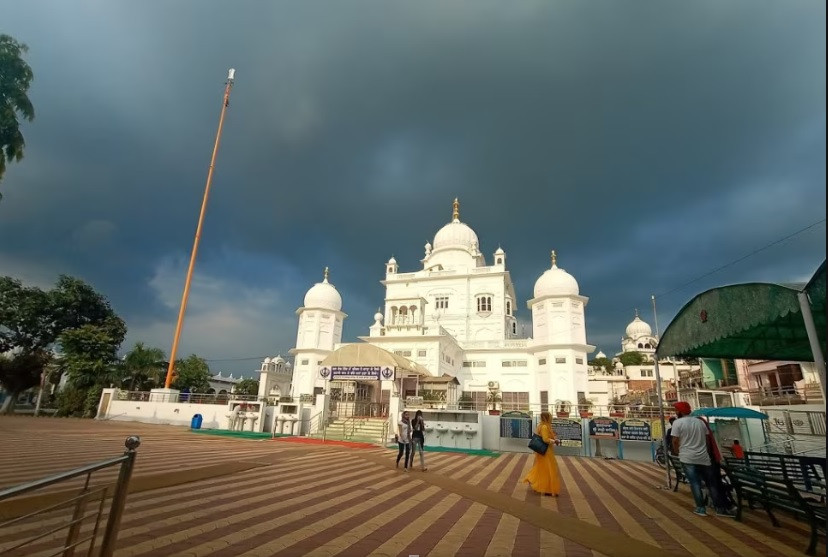 Gurudwara Katalgarh Sahib lies west of Gurudwara Garhi Sahib and is the main shrine at Sri Chamkaur Sahib. During the battle of Chamkaur in 1704 in which Sri Guru Gobind Singh Ji and 40 Sikhs fought against overwhelming odds, both of Sri Guru Gobind Singh Ji’s sons, Baba Ajit Singh Ji and Baba Jujhar Singh Ji got martyred. It was here Sri Guru Gobind Singh Ji, when informed about the martyrdom of his two sons, had said that not just two but all Sikhs were his beloved sons.
Gurudwara Katalgarh Sahib lies west of Gurudwara Garhi Sahib and is the main shrine at Sri Chamkaur Sahib. During the battle of Chamkaur in 1704 in which Sri Guru Gobind Singh Ji and 40 Sikhs fought against overwhelming odds, both of Sri Guru Gobind Singh Ji’s sons, Baba Ajit Singh Ji and Baba Jujhar Singh Ji got martyred. It was here Sri Guru Gobind Singh Ji, when informed about the martyrdom of his two sons, had said that not just two but all Sikhs were his beloved sons.
Anandgarh Fort
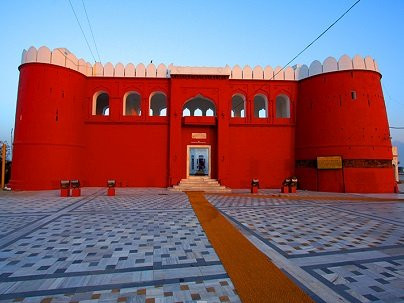 A huge, red-bricked structure in Anandpur Sahib, Anandgarh Fort is one of the five forts built by Sri Guru Gobind Singh Ji to protect Sikhs and other residents from the Mughals. It is believed that the construction of this fort began in 1689 and took over 10 years to complete, whereas, later it was reconstructed in 1970, but one can still trace the marks of the old, original structure. It is a must visit on your trip to Rupnagar.
A huge, red-bricked structure in Anandpur Sahib, Anandgarh Fort is one of the five forts built by Sri Guru Gobind Singh Ji to protect Sikhs and other residents from the Mughals. It is believed that the construction of this fort began in 1689 and took over 10 years to complete, whereas, later it was reconstructed in 1970, but one can still trace the marks of the old, original structure. It is a must visit on your trip to Rupnagar.
Dastaan-e-Shahadat
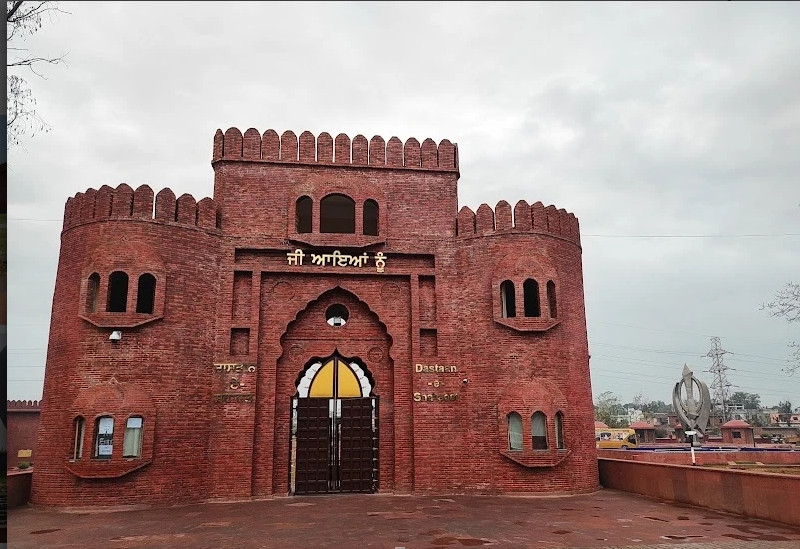 A world class museum dedicated to the battle of Chamkaur Sahib, with name and theme of “Dastaan-e- Shahadat is also at Sri Chamkaur Sahib, Punjab. This theme park is being built at a place of prime religious and historical importance because of being the place of sacrifice made during the battle of Chamkaur. The theme park and the museum exhibit rich and glorious history with ultra- modern techniques of multimedia-based technology like projection mapping, murals and animation films and a blend of traditional & contemporary art.
A world class museum dedicated to the battle of Chamkaur Sahib, with name and theme of “Dastaan-e- Shahadat is also at Sri Chamkaur Sahib, Punjab. This theme park is being built at a place of prime religious and historical importance because of being the place of sacrifice made during the battle of Chamkaur. The theme park and the museum exhibit rich and glorious history with ultra- modern techniques of multimedia-based technology like projection mapping, murals and animation films and a blend of traditional & contemporary art.
Dams & Wetlands
Dams
Near the border between Punjab and Himachal Pradesh in northern India, Bhakra Dam is a concrete gravity dam across the Sutlej River. Bhakra Dam holds the record of Asia’s second tallest at 225.55 m (740 ft) high next to the 261m Tehri Dam also in India. Its reservoir, known as the “Gobind Sagar”, stores up to 9.34 billion cubic meters of water. This 90 km long reservoir created by the Bhakra Dam is spread over an area of 168.35 km2. In terms of storage of water, it is the third largest reservoir in India. Once described as ‘New Temple of Resurgent India’ by Jawaharlal Nehru, the first prime minister of India, the dam attracts a large number of tourists who visit for its attractive location and panoramic view.
Nangal Dam is another dam of Punjab which is located downstream of Bhakra Dam. These dams were designed and built to prevent flooding in the Sutlej-Beas River valley and also to produce hydroelectricity & provide irrigation waters to the adjoining States. International tourists require special prior permissions from Bhakra Beas Management Board to visit this place.
(Timings: 10 am to 6 pm (Monday-Friday!
Wetlands
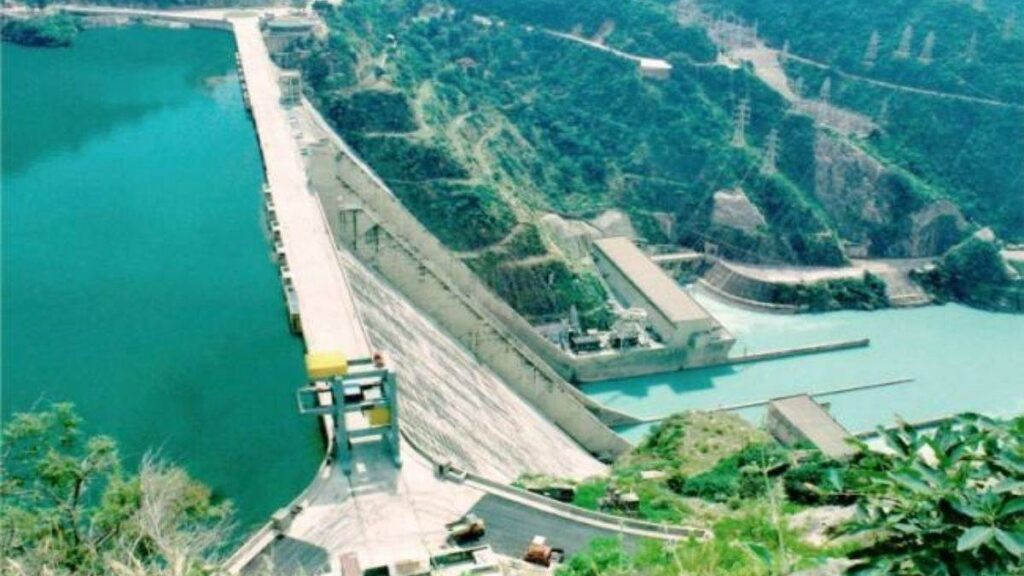 Located in the Shivalik foothills of the lower Himalayas. Rupnagar Wetland also known as Rupnagar Lake has a diverse and rich biodiversity, making it one of the most popular tourist attractions for bird watching and boating. It is home to distinct, rare & endangered species such as Turtle ‘Chitra Indica’ and the threatened snake ‘Python Molurus’, Ropar Wetland has been designated as a Ramsar site of international importance. Just like Rupnagar Wetland, Nangal Wetland also serves as a home for numerous species of resident as well as migrant birds covering around 700 acres. The special attractions for tourists visiting this place are red jungle fowl, large Indian parakeet, Indian cuckoo, woodshrike, yellow-eyed babbler and crested bunting. Nangal Wetland also is home to some of the rare and threatened species such as Sarus crane, Indian pangolin, Indian otter, the hog deer & the sambar
Located in the Shivalik foothills of the lower Himalayas. Rupnagar Wetland also known as Rupnagar Lake has a diverse and rich biodiversity, making it one of the most popular tourist attractions for bird watching and boating. It is home to distinct, rare & endangered species such as Turtle ‘Chitra Indica’ and the threatened snake ‘Python Molurus’, Ropar Wetland has been designated as a Ramsar site of international importance. Just like Rupnagar Wetland, Nangal Wetland also serves as a home for numerous species of resident as well as migrant birds covering around 700 acres. The special attractions for tourists visiting this place are red jungle fowl, large Indian parakeet, Indian cuckoo, woodshrike, yellow-eyed babbler and crested bunting. Nangal Wetland also is home to some of the rare and threatened species such as Sarus crane, Indian pangolin, Indian otter, the hog deer & the sambar
Nangal Wildlife Sanctuary
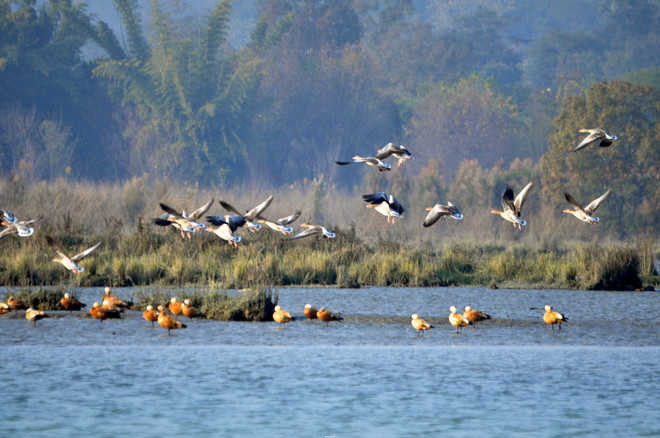 A unique wetland on account of its pristine blue-green water which is an excellent habitat for migratory as well as resident birds and other aquatic flora & fauna, Nangal Wildlife Sanctuary is a perfect mixture of hilly terrain and plain land, with a huge water body covering a good number of trees, grasses and shrubs. The Nangal Wildlife Sanctuary came into existence with the completion of the Bhakra and Nangal Dam in 1963. Like Harike and Ropar Wetlands, it also draws sustenance from the river Sutlej. The Nangal Wildlife sanctuary has been designated as a Ramsar site of international importance.
A unique wetland on account of its pristine blue-green water which is an excellent habitat for migratory as well as resident birds and other aquatic flora & fauna, Nangal Wildlife Sanctuary is a perfect mixture of hilly terrain and plain land, with a huge water body covering a good number of trees, grasses and shrubs. The Nangal Wildlife Sanctuary came into existence with the completion of the Bhakra and Nangal Dam in 1963. Like Harike and Ropar Wetlands, it also draws sustenance from the river Sutlej. The Nangal Wildlife sanctuary has been designated as a Ramsar site of international importance.
Nangal has a number of other attractions for tourist like Gurudwara Bhibhour Sahib, Gurudwara Ghat Sahib and the temple of Lakshmi Narayanjulfa Mata Temple.
Naina Devi Temple
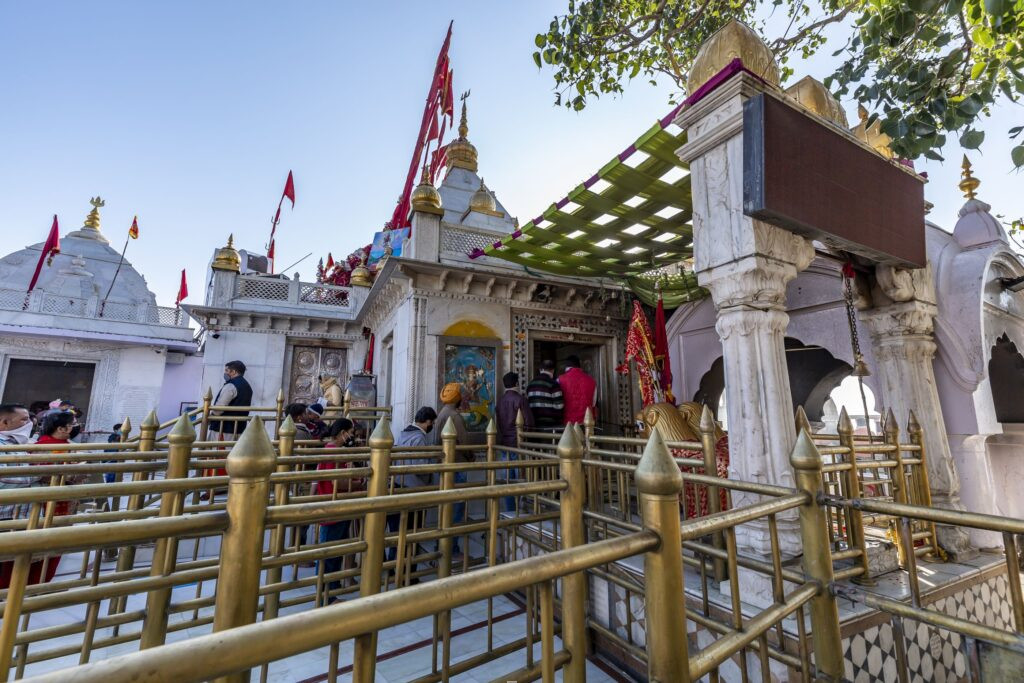 This 8th century temple is located 19 kms away from Anandpur Sahib in the State of Himachal Pradesh. The Naina Devi Temple is considered very holy because of its being one of the Shaktipeeths where it is believed that the eyes of Sati fell on the earth. Naina Devi witnesses huge crowd round the year and particularly during navratras. A ropeway is being developed for the pilgrims and visitors to ride between Sri Naina Devi and Sri Anandpur Sahib.
This 8th century temple is located 19 kms away from Anandpur Sahib in the State of Himachal Pradesh. The Naina Devi Temple is considered very holy because of its being one of the Shaktipeeths where it is believed that the eyes of Sati fell on the earth. Naina Devi witnesses huge crowd round the year and particularly during navratras. A ropeway is being developed for the pilgrims and visitors to ride between Sri Naina Devi and Sri Anandpur Sahib.
Kiratpur Sahib
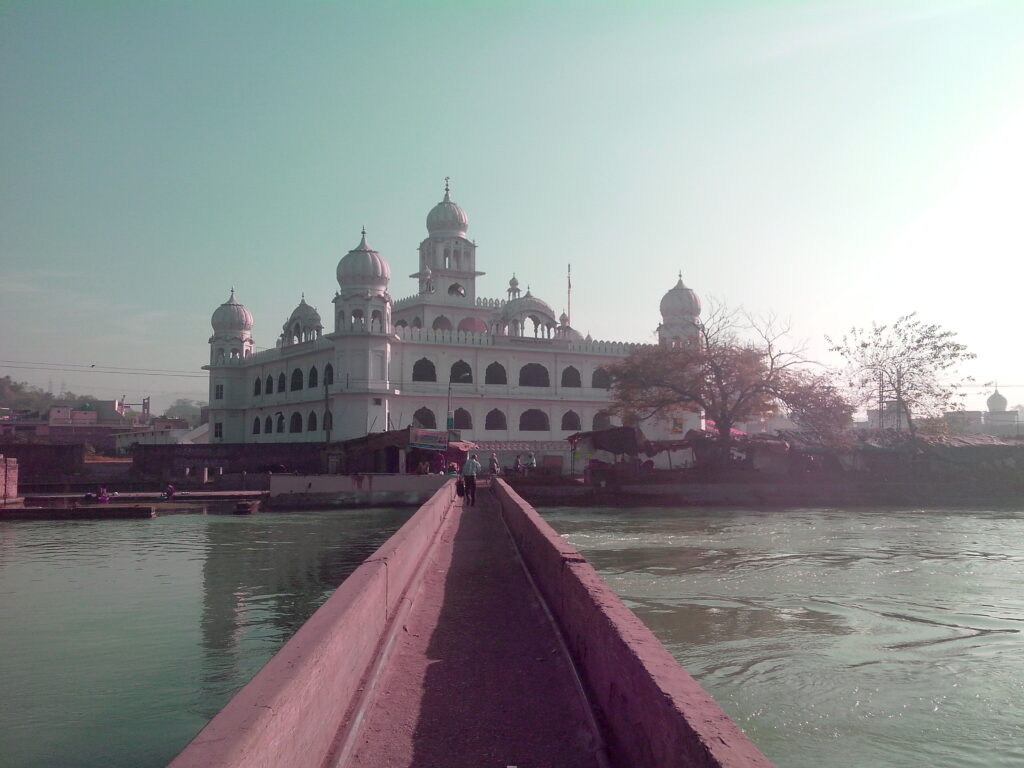 Just 10 kms from Anandpur Sahib is the place blessed by enlightened souls like Sri Guru Hargobind Sahib Ji, Sri Guru Nanak Dev Ji and Pir Buddan Shah, known as Kiratpur Sahib. Kiratpur Sahib is also famous as the place with sorne of the most revered Gurudwaras, like Charan Kamal, Baba Gurditta, Bavangarh, Patal Puri Sahib and Majar Pir Sai Buddan Shah. Sikhs from all across the world visit this place to immerse ashes of their departed ones in the river Sutlej.
Just 10 kms from Anandpur Sahib is the place blessed by enlightened souls like Sri Guru Hargobind Sahib Ji, Sri Guru Nanak Dev Ji and Pir Buddan Shah, known as Kiratpur Sahib. Kiratpur Sahib is also famous as the place with sorne of the most revered Gurudwaras, like Charan Kamal, Baba Gurditta, Bavangarh, Patal Puri Sahib and Majar Pir Sai Buddan Shah. Sikhs from all across the world visit this place to immerse ashes of their departed ones in the river Sutlej.
Gurudwara Sri Bibhour Sahib
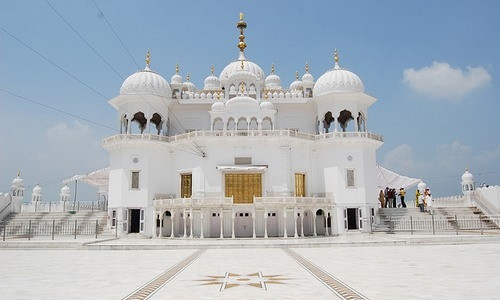 Situated on the banks of river Sutlej, Gurudwara Sri Bibhour Sahib is the place where Sri Guru Gobind Singh Ji composed Sri Choupai Sahib, which is one of the five Banis mandatory for every baptized Sikh to recite every day.
Situated on the banks of river Sutlej, Gurudwara Sri Bibhour Sahib is the place where Sri Guru Gobind Singh Ji composed Sri Choupai Sahib, which is one of the five Banis mandatory for every baptized Sikh to recite every day.
Kissan Haveli
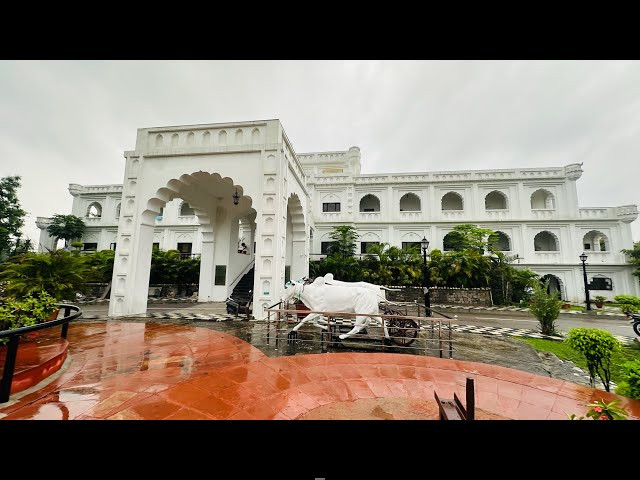 An affordable yet happening place to stay at Anandpur Sahib. The booking for stay in the Haveli is done by the Punjab Mandi Board.
An affordable yet happening place to stay at Anandpur Sahib. The booking for stay in the Haveli is done by the Punjab Mandi Board.
Ideal Time to Visit
Being a holy city, you can visit Anandpur Sahib anytime. During summers, if you’re headed towards Manali side, you can stop over here to seek the Gurus’ blessing. March would be a good time to visit during the famous Hola Mahalla festival, where different tenants of Sikhism – bravery, courtesy, openness and social welfare can be witnessed. One may capture any colour during the celebrations.